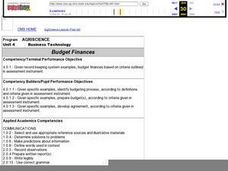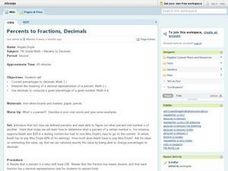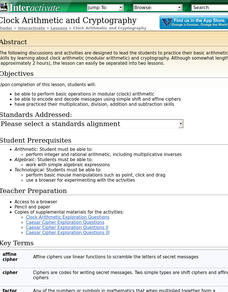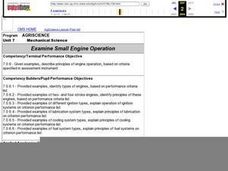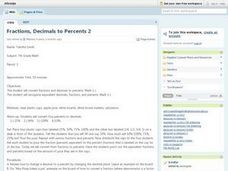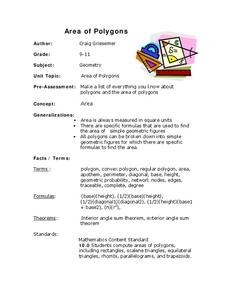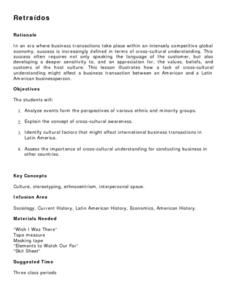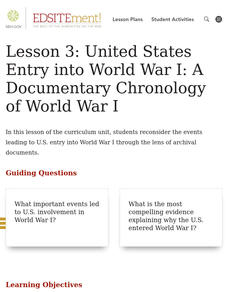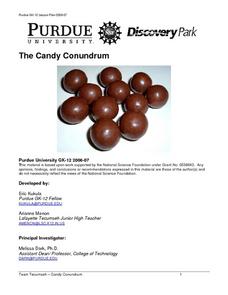Curated OER
Budget Finances
Students role play the role of a recent graduate of high school living on their own. Using play money, they are given one month's salary and they discover they own their own house or apartment and owe money on a car loan. They develop...
Curated OER
Making Changes
Students observe and record the changes they see when adding heat and cold to objects. In this changes lesson plan, students experiment with different objects and see if heat and cold change the makeup of the object. They then record...
Curated OER
Get In Line!
Students compare and order fractions and decimals using a number line. They use rules of conversion to determine equivalencies competing problems accurately and plot points on the number line that represent the correct order of the...
Curated OER
Use Scientific Method to Solve Problems
Students are given a set problem, they use the scientific method to solve the problem using all steps of the scientific research. Students list the steps of the scientific method used in solving a problem. They are given a selected...
Pennsylvania Department of Education
Adding and Subtracting Three-Digit Numbers by Jumping
Second graders use data to graph information and draw conclusions. In this instructional activity on data analysis, 2nd graders practice gathering, sorting, comparing, and graphing data. Students differentiate data that can and cannot...
Curated OER
Percents to Fractions and Decimals
Seventh graders practice converting percentages to decimals. Through guided practice, they work to solve problems involving converting fractions to decimals. Working in pairs, 7th graders compete to be the first to solve the problem...
Curated OER
Oral Language in Mathematics
Third graders examine fractions by descriptively writing about them. For this number sense lesson, 3rd graders read number sentences and compare fractions based on their size. Students explain fractions to a friend by writing a friendly...
Curated OER
Clock Arithmetic and Cryptography
Students investigate modular clock arithmetic and cryptography. They perform basic operations in modular (clock) arithmetic and encode and decode messages using simple shift and affine ciphers.
Curated OER
Mechanical Science - Small Engine Operation
Students experiment with two- and four-stroke engines. They conduct experiments to determine how atmospheric pressure affects the engine's running capability. Further tests are conducted to asses proper llubrication and its affects on...
Curated OER
Fractions, Decimals to Percents
Seventh graders convert fractions and decimals to percents. Using measuring cups, 7th graders model fraction/percent equivalents. They discuss how to change a decimal to a percent. Using the white boards, students review the different...
Curated OER
Clock Arithmetic and Cryptography
Students explore the concept of modular arithmetic and cryptography. In this modular arithmetic and cryptography lesson, students use applets to explore modular arithmetic using a clock and Caesar Ciphers. Students exchange their ciphers...
Pennsylvania Department of Education
Using Multiplication to Solve Word Problems
Fourth graders solve word problems using multiplication. In this multiplication lesson, 4th graders write and solve word problems using their prior knowledge of multiplication.
Curated OER
Number Line
Explore how to make a number line and how to mark the numbers along the number line using fraction and decimal notation. Your scholars will compare and order fractions and decimals and find their appropriate position on the number line.
Curated OER
Area of Polygons
Students engage in a lesson that is about the concept of polygons and focuses upon finding the area. They use formulas provided in the lesson in order to solve problems given by the teacher for independent practice. Geometric figures are...
Curated OER
Stamp Act: Virtual Representation vs. Actual Representation
Eleventh graders research and discuss the different points of view of colonists in terms of taxation, as well as how these viewpoints helped lead to the revolution.
Curated OER
Some see art, some see vandalism
Students find out what the laws are concerning graffiti in the community. Is it a misdemeanor, does being caught result in a fine? Jail? Community service to remove it? The information is found by interviewing key people in the community.
Curated OER
Retraidos
Learners discuss the statement "You can buy in any language, you sell in the language of the customer." Students watch a demonstration of personal space and discuss the different distances that various cultures assign as appropriate...
Curated OER
Investigation - What's the Number?: Division
Seventh graders explore number sentences using a variety of strategies making each equation a true sentence. Students examine strategies such as patterns, trial and error, working backwards, and related problems. In groups, 7th graders...
Curated OER
Meet Your New eBuddy
Students are introduced to the eBuddies laptop system. Using the technology, they create a new Word document and practice using a mouse. Opening a new window from Internet Explorer, they view an appropriate site which allows them to...
Curated OER
Symbiosis and Co-evolution
By choosing a species and researching an adaptive symbiotic relationship it shares with another species, your students are able to investigate a symbiotic relationship in a lab setting. They create a presentation using a variety of...
Curated OER
What I Love about My Neighborhood
Young scholars explore what their neighborhood means to them. In this community lesson, students express what they like about their neighborhood. Young scholars examine neighborhoods and what is special about their neighborhood and...
Curated OER
Probability or Ability?
Students toss candy and coins using their non-dominant hand while their partners records the results on a probability charts.
Curated OER
United States Entry into World War I: A Documentary Chronology of World War I
Eleventh graders reconsider the events leading to U.S. entry into World War I through the lens of archival documents.
Curated OER
The Candy Conundrum
Students design a candy container that contains a specific amount of candy. They demonstrate how an engineering problem can be solved with math and that there are multiple answers to the problem. They compute volume of spheres.
